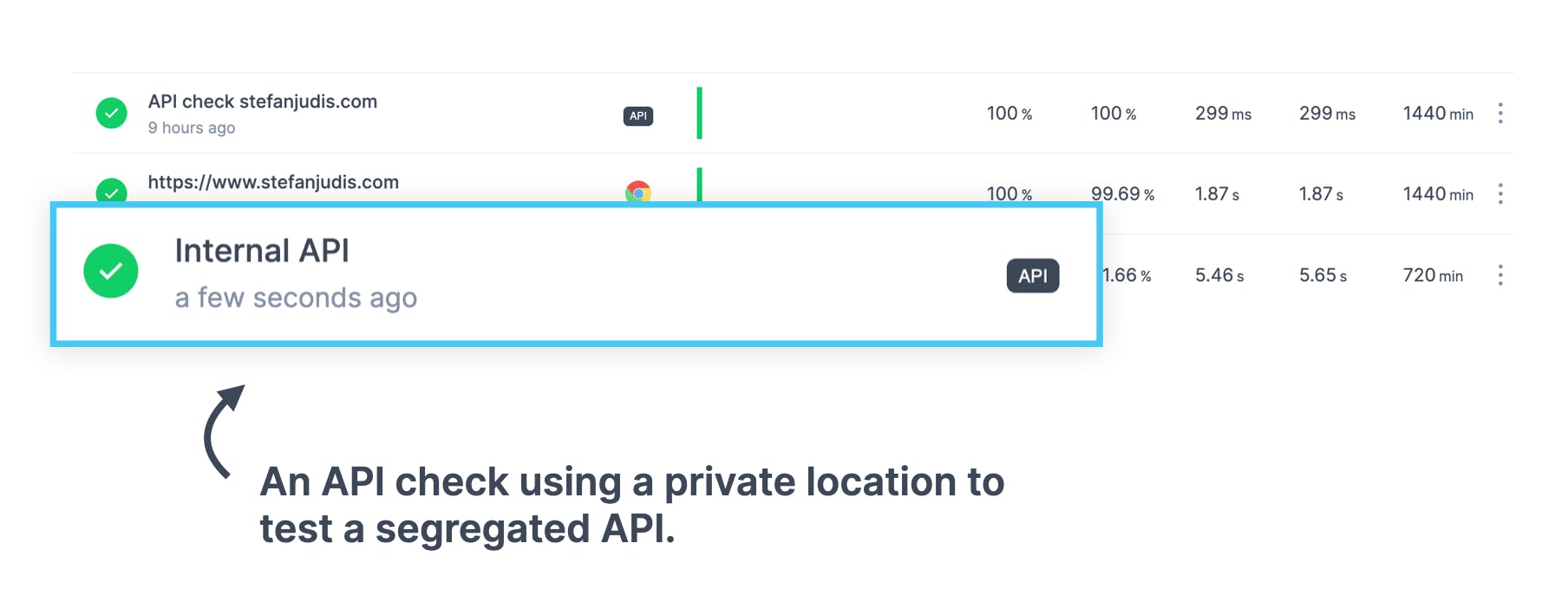The monitoring and testing of public applications and APIs is challenging by itself. What should you test? How often should you run your tests? And who should be alerted?
A scalable monitoring setup includes many hidden details, but technically it’s straightforward. Call public APIs and see if they do what they’re supposed to.
You can already test your public apps from various locations using Checkly, but what if you want to monitor and test segregated applications and APIs that aren’t publicly available? Your internal APIs deserve the same care as the public ones, don’t they?
Many of you asked us how to approach the testing of internal applications, and we’re excited to tell you that you can now test your internal APIs and applications using Checkly, too!
Sounds intriguing?
Watch the TL;DR video above or read on!
Our solution – a local test runner
After talking with our customers, we learned that segregated application monitoring often results in two different test setups.
They use Checkly to cover the public surface and run their API monitoring and browser-based end-to-end tests right from the cloud. Additionally, they set up a separate monitoring infrastructure for their internal applications in private networks. That’s doubled effort with half the fun – and it’s not great!
We went to the drawing board to figure out how you could use Checkly’s infrastructure to test your segregated applications, and the result is... 🥁 our brand new Checkly Agent.
It’s the best of both worlds!
Countless new check locations running in your infrastructure
The Checkly Agent is a container-based tool to run API and browser checks right in your infrastructure. It’s based on the code we run in production packaged into an OCI-compliant container so you can use it with Docker, Kubernetes, Podman, etc.
How cool is that?
You can now install and start the agent to run API and browser end-to-end tests against your internal applications because it’s running in your infrastructure.
Running checks is only a tiny part of successful monitoring, though.
To be sure that all your apps (the public and private ones) are up and behaving, it’s essential to define appropriate check intervals, store check results over time, and alert when things go wrong. And that’s why our new agent automatically connects to the Checkly cloud.
Scheduling, alerting and saving the results still happen in the Checkly infrastructure, so you don’t have to worry about them. A running agent is “just another configurable location”. Run checks from our infrastructure in Ireland, the US or São Paulo, or your own one like your private data center.

We call these agent-based locations private locations.
How to set up a new private location
With the release of the Checkly Agent, we now give you the tools to run browser and API checks within your infrastructure while still providing you alerts, over-time insights, and test scheduling.
Find detailed setup instructions in our private location documentation.
But in short, the required steps are:
- Create a new private location and a new API key.
- Install and run the container in your infrastructure using this API key to retrieve, run and store checks and their results.
- Write your checks in the Checkly UI and get your internal application testing rollin’.
Afterwards, you can create and run checks in the Checkly UI as usual and all your locations (private and public ones) are at your fingertips after the setup.
But how does it work? Agents calling home!
Checkly Agents are designed to be stateless, scaleable and ephemeral so that you can add and remove them at any time.
An extra tip: run at least two agents in your infrastructure to guarantee redundancy in case of a failure. Read more about how to scale agents in the documentation.
A running Checkly agent continuously polls the Checkly backend to learn about pending checks. It runs the tests and reports the results back to the Checkly infrastructure if there are any. Remember, it’s the same code we run in the public AWS locations. 💪
Check result dashboards, configuration, and interval schedules work the same as in our public locations. There’s nothing new to learn!

If registered agents go down and stop asking for new checks to run, we’ll notify you that it’s awkwardly quiet, so you can put on your debugging hat to see what’s up.
Summary
Private locations eliminate the need for yet another monitoring setup. We’re excited to announce that you can now test all your public and (!) private APIs and applications using Checkly.
Install the Checkly Agent and watch how it automatically does all the heavy lifting so you can continue building and testing your applications instead of building another testing infrastructure. Yay!
If you want to learn more about private locations, head on to the documentation. I’m excited to learn more about what you think.
Until then, happy monitoring and say “Hi” to your agents from me!

